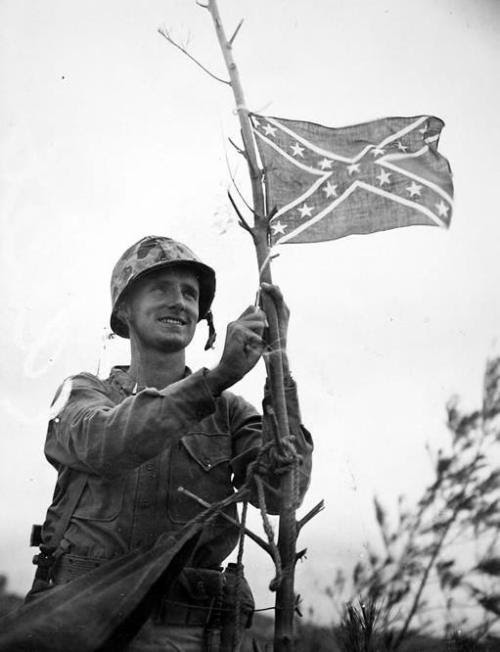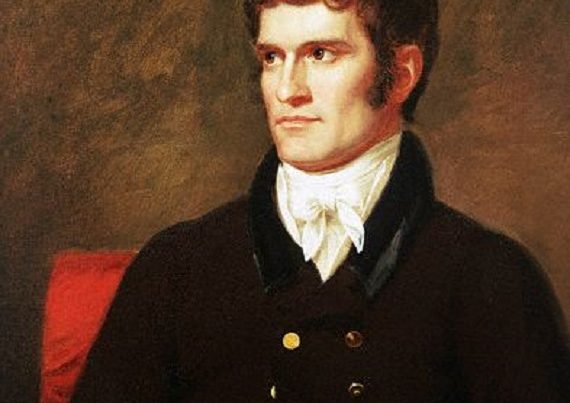Five days ago I posted an article citing Eugene Sledge’s With the Old Breed that stated the first American flag to fly over the conquered Japanese fortress at Shuri Castle during the World War II battle of Okinawa was the Confederate battle flag. Sledge, who was present, wrote:
Earlier in the morning [of May 29, 1945] . . . Marines had attacked eastward into the rains of Shuri Castle and had raised the Confederate flag. When we learned that the flag of the Confederacy had been hoisted over the very heart and soul of Japanese resistance, all of us Southerners cheered loudly. The Yankees among us grumbled . . .
Since Sledge was an Alabaman, I additionally noted that Professor Greg Grandin of New York University wrote in an article about Confederate symbols: “In World War II . . . the first flag Marines raised upon taking the [Okinawa] headquarters of the Japanese Imperial Army was the Confederate one. It had been carried into battle in the helmet of a captain from South Carolina.”
The battle of Okinawa began seventy-three years ago today, which was also an Easter Sunday. Several sources such as The Marine Corps Association & Foundation report that South Carolina Marine Captain Julius Dusenberg raised the flag. But the captain’s grandson, Stuart Moore, reveals a more complete and interesting story.
First, the captain’s correct name was Julian Dusenbury. He was the Executive Officer of cadets at Clemson University in December 1941. After the Japanese attack on Pearl Harbor he led a group of students in a patriotic demonstration on the lawn of the University President’s house to proclaim that they would leave school to enlist. Southerners have long been among the most willing to serve in the American army. Dusenbury’s grandson, Stuart, was among them. Even today forty percent of our troops come from the South as compared to fifteen percent from the Northeast.
Second, the captain led the assault that captured Shuri Castle, the last major Japanese stronghold on the island. “The night prior to the assault . . . Julian crawled through mud, over bodies, and sneaked past Japanese sentries nine times to drag back boxes of ammunition through enemy lines to his men.” During the wiping up process a sniper shot him, putting him in a wheelchair for his remaining thirty years. After he was evacuated, his men found the Confederate flag in his helmet. Since “they had no formal US colors to fly they flew my grandfather’s, in part to show their victory but also to show their love and respect for their ‘skipper.’” Journalist Ernie Pyle commented upon this affection for Dusenbury in one of his books.
Third, according to his grandson Stuart, the captain “was put up for the Medal of Honor. . . but even in 1945 political correctness” about the Confederate flag blocked it. Instead, he received the Navy Cross but never bemoaned or regretted his failure to get the Medal of Honor.
Fourth, Dusenbury “returned to South Carolina where he was elected to the state legislature . . . and died in 1976. Although he was [incorrectly] attributed with the controversial flag raising. . . he went to his grave saying he preferred being known [even erroneously] for flying the Confederate banner, over winning our nation’s highest honor.”
As Carlos Eire put it in Waiting for Snow in Havana, “Show me history untouched by memories and you show me lies. Show me lies not based on memories and you show me the worst lies of all.”








Very fascinating and inspiring history, thanks for sharing!
Very good article. My dad was at Okinawa too. He was a Seabee so he got in after the worst combat was over. Even though he was originally from Missouri and people on my dad’s side of the family fought with “irregulars” against the Kansas Red Legs, he was not a big promoter of “confederate flags.” He didn’t have a problem with them but didn’t carry one or display one. He said he saw them and no one seemed to have a problem with them at the time.
The “confederate flag” as some have called it was of course the “Battle Flag” of the Northern Army of Virginia and not accepted as the flag of the Confederate States of America. Also, what so many people have missed about that flag over the years (especially now) is that it did not represent racist feeling necessarily but the resentment that built up over the years after the end of the Civil War and feeling of defeat that so many Southerners felt. They felt put down, put upon and looked down at. To them that flag represented a feeling of resistance and standing up for where they came from. People seem to forget the feelings ran deep. Many Southern towns up till the 2nd World War didn’t even celebrate the 4th of July.